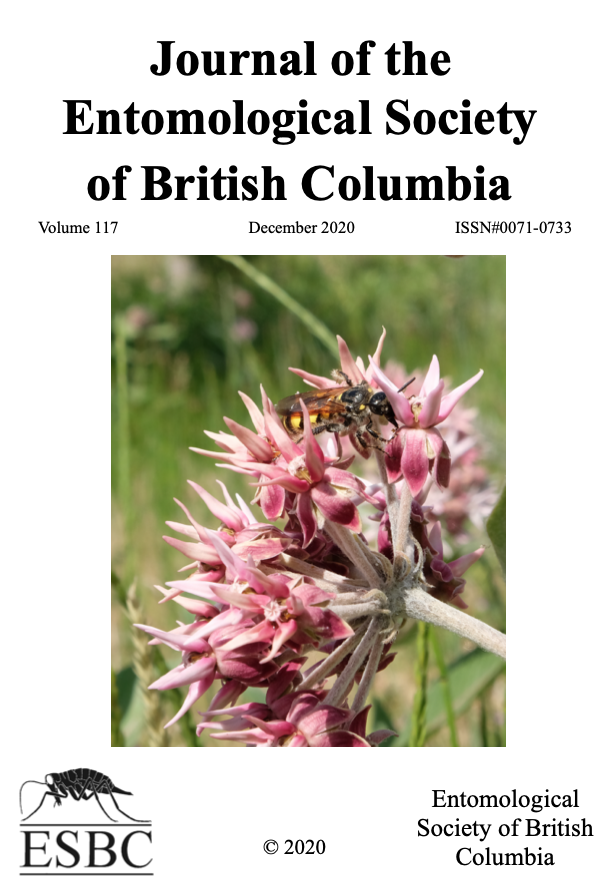First record of the Palearctic seed bug Metopoplax fuscinervis Stål (Hemiptera: Oxycarenidae) in North America
Abstract
NoneReferences
Abram, P.K., Hueppelsheuser, T., Acheampong, S., Clarke, P., Douglas, H., and Gariepy, T.D. 2017. Evidence of established brown marmorated stink bug populations in British Columbia, Canada. Journal of the Entomological Society of British Columbia, 114: 83–86.
Aukema, B., Bos, F., Hermes, D., and Zeinstra, P. 2005. Nieuwe en interessante Nederlandse wantsen II, met een geactualiseerde naamlijst (Hemiptera: Heteroptera). Nederlandse faunistische mededelingen, 23: 37–76.
Baugnee, J.Y., Dethier, M., Constant, J., Bruers, J., Viskens, G., and Bruge, H. 2000. New or remarkable bugs for the Belgian fauna [Metopoplax fuscinervis and Acompus pallipes]. Bulletin de la Société Royale Belge d'Entomologie, 136: 124–143.
Deckert, J. 2004. Zum Vorkommen von Oxycareninae (Heteroptera, Lygaeidae) in Berlin und Brandenburg. Insecta, 9: 67–75.
Dellapé, P.M. and Henry, T.J. 2020. Lygaeoidea Species File. Version 5.0/5.0 [Online]. Available from http://Lygaeoidea.SpeciesFile.org [accessed 4 February 2020].
Hanley, N. and Roberts, M. 2019. The economic benefits of invasive species. People and Nature, 1:124– 137.
Harvey, P. 2008. Around the British Isles: S & N Essex. Het News, 12: 16. Available from https:// www.britishbugs.org.uk/HetNews/Issue%2012_Autumn%202008_2422Kb.pdf [accessed 12 August 2020].
Henry, T.J. 1997. Phylogenetic analysis of family groups with the infraorder Pentatomomorpha (Hemiptera: Heteroptera), with emphasis on the Lygaeoidea. Annals of the Entomological Society of America, 90: 275–301.
Henry, T.J., Dellapé, P.M., and Scudder, G.G.E. 2015. Resurrection of the genera Crophius Stål and Mayana distant from synonymy under Anomaloptera Amyot and Serville, description of a new genus, and a key to the New World oxycarenid genera (Hemiptera: Heteroptera: Oxycarenidae) Proceedings of the Entomological Society of Washington, 117: 367–380.
Heiss, E. and Scudder, G.G.E. 2019. Aradidae (Heteroptera) new to North America and Canada, with some additional provincial and state records for Canada and the USA. Linzer Biologische Beiträge, 51: 821–829.
Lattin, J.D. and Wetherill, K. 2002. Metopoplax ditomoides (Costa), a species of Oxycarenidae new to North America (Lygaeoidea: Hemiptera: Heteroptera). Pan-Pacific Entomologist, 78: 63–65.
Lodge, D.M., Williams, S., MacIsaac, H.J., Hayes, K.R., Leung, B., Reichard, S., Mack, R.N., Moyle, P.B., Smith, M., Andow, D.A., Carlton, J.T., and McMichael, A. 2006. Biological invasions: recommendations for U.S. policy and management. Ecological Applications, 16: 2035–2054.
Péricart, J. 1999. Hémiptères Lygaeidae Euro-Méditerranéens. 2. Faune de France, 84B [1998]: 1–453. Ratzlaff, C.G. and Scudder, G.G.E. 2018. First records of the juniper shield bug, Cyphostethus tristriatus (Fabricius, 1787) (Hemiptera: Acanthosomatidae), in North America. Pan-Pacific Entomologist, 94:
–74.
Scudder, G.G.E. 2012. Monosteira unicostata (Mulsant & Rey) (Hemiptera: Tingidae) established in
North America, with a key to the genera of Tingidae in Canada. Entomologica Americana, 118:
–297.
Wheeler, A.G., Jr. and Hoebeke, E.R. 2012. Metopoplax ditomoides (Costa) (Hemiptera,: Lygaeoidea:
Oxycarenidae): First Canadian record of a Palearctic seed bug. Journal of the Entomological Society of British Columbia, 108: 70–71.
Downloads
Published
Issue
Section
License
Authors who publish with the Journal of the Entomological Society of British Columbia agree to the following terms:
-Authors retain copyright and grant the journal right of first publication with the work simultaneously licensed under a Creative Commons Attribution License that allows others to share the work with an acknowledgement of the work's authorship and initial publication in this journal.
-Authors are able to enter into separate, additional contractual arrangements for the non-exclusive distribution of the journal's published version of the work (e.g., post it to an institutional repository or publish it in a book), with an acknowledgement of its initial publication in this journal.
-Authors are permitted and encouraged to post their work online (e.g., in institutional repositories or on their website) prior to and during the submission process, as it can lead to productive exchanges, as well as earlier and greater citation of published work (See The Effect of Open Access).


